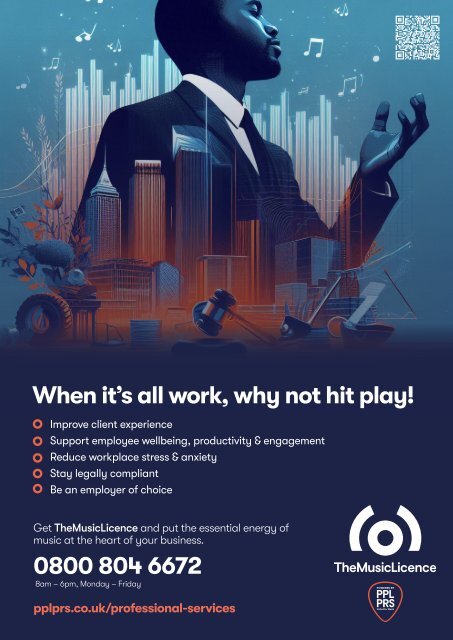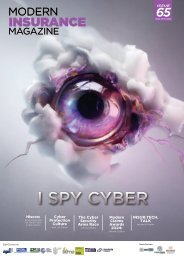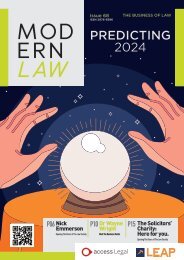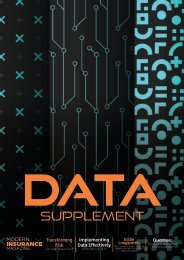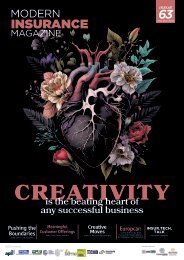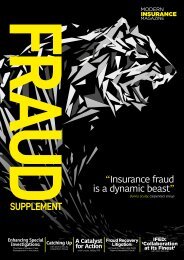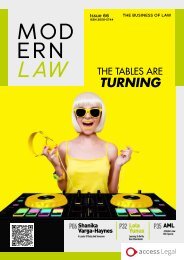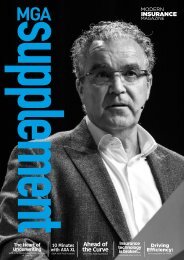Modern Law Magazine Issue 67
You also want an ePaper? Increase the reach of your titles
YUMPU automatically turns print PDFs into web optimized ePapers that Google loves.
FORUM<br />
What role can technology, such as blockchain or smart contracts, play<br />
in making conveyancing processes more environmentally friendly, and<br />
what challenges might arise in their implementation?<br />
When it’s all work, why not hit play!<br />
Improve client experience<br />
Support employee wellbeing, productivity & engagement<br />
Reduce workplace stress & anxiety<br />
Stay legally compliant<br />
Be an employer of choice<br />
Mike: Technology, including blockchain and smart contracts, can<br />
significantly contribute to making conveyancing processes more<br />
environmentally friendly. Blockchain, with its decentralised and<br />
tamper-resistant ledger, can enhance transparency and security in<br />
property transactions, reducing the need for physical paperwork<br />
and minimising the environmental impact of paper production.<br />
Smart contracts, powered by blockchain, can automate<br />
and streamline various stages of the conveyancing process,<br />
eliminating the need for excessive paperwork and reducing the<br />
carbon footprint associated with document transportation and<br />
storage. However, challenges in implementing these technologies<br />
may arise. First, there’s the issue of widespread adoption and<br />
standardisation, as all stakeholders in the real estate industry<br />
need to embrace these technologies for maximum efficiency.<br />
Additionally, ensuring the security and privacy of sensitive<br />
property data within blockchain systems is crucial. There may also<br />
be technical hurdles in transitioning from traditional conveyancing<br />
methods to a more technologically driven approach. Nevertheless,<br />
as these challenges are addressed, the integration of blockchain<br />
and smart contracts into conveyancing can play a substantial role<br />
in achieving a more environmentally friendly and efficient real<br />
estate transaction process.<br />
“Adopting environmentally<br />
conscious practices in<br />
conveyancing can carry potential<br />
cost implications, but they can<br />
be managed effectively.”<br />
David: Clearly the more tech is deployed in the conveyancing<br />
transaction, the less the physical carbon footprint of the<br />
operation. Digital documentation, data transfer, docusign and<br />
electronic communications including status updates are all<br />
supporting the acceleration to paperless process. There is a<br />
natural human resistance to change, and the notepad isn’t leaving<br />
the conveyancer’s desk any time soon, but for a firm that has just<br />
started the tech adoption journey and is staring at a cabinet full<br />
of paper files, reducing the firm’s footprint requires a significant<br />
culture change - and not before time!<br />
Chris: Digitisation is an environmentally friendly initiative<br />
compared to more traditional conveyancing methods. Every<br />
stakeholder will likely agree that the emergence of further<br />
digital services – such as smart contracting or the AI analysis of<br />
leasehold contracts – are also all positive initiatives. However,<br />
we are venturing into a new world. How do we robustly regulate<br />
emerging technology? The sector needs new standards, processes<br />
and governance; and the only way to scale technology quickly is if<br />
the sector delivers the solutions. For example, The Conveyancing<br />
Information Executive, which Landmark helped to establish, has<br />
developed as the standards body that determines the information<br />
that should go into property reports. Our core decision-making<br />
model is changing, and it needs support to fulfil its potential. Put<br />
simply, if we follow the digitisation journey to an end point, then<br />
a transaction will happen off the back of visual representation<br />
of information alone. For example, users will be supplied with a<br />
RAG or smart workflow as a summary statement. However, the<br />
information that underpins this output is hidden or inaccessible<br />
because of the requirement for speed. All this means that the<br />
digitisation process will require evidence and audit as well as a<br />
high degree of trust from the conveyancer where the validation of<br />
the decisions made isn’t always visible yet must still be recorded.<br />
Conveyancers make big decisions based on risk. The challenge<br />
now is ensuring that lawyers (and wider market stakeholders)<br />
understand how technology and data interact and are managed in<br />
order to be clear on risk and the controls in a digital first world.<br />
Get TheMusicLicence and put the essential energy of<br />
music at the heart of your business.<br />
0800 804 6<strong>67</strong>2<br />
8am – 6pm, Monday – Friday<br />
pplprs.co.uk/professional-services<br />
59


